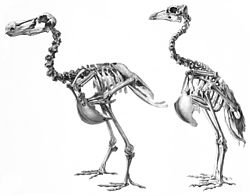| Raphines Temporal range:
| |
|---|---|

| |
| Dodo and Rodrigues solitaire skeletons compared, not to scale | |
| Scientific classification | |
| Domain: | Eukaryota |
| Kingdom: | Animalia |
| Phylum: | Chordata |
| Class: | Aves |
| Order: | Columbiformes |
| Family: | Columbidae |
| Subfamily: | Raphinae |
| Tribe: | Raphini |
| Subtribe: | †Raphina Oudemans, 1917 (Young et al., 2024)[1] |
| Type species | |
| †Raphus cucullatus | |
| Genera | |

| |
| Former range (in red) | |
| Synonyms[2] | |
|
List
| |
The Raphina are a clade of extinct flightless birds formerly called didines or didine birds.[c] They inhabited the Mascarene Islands of Mauritius and Rodrigues, but became extinct through hunting by humans and predation by introduced non-native mammals following human colonisation in the 17th century. Historically, many different groups have been named for both the dodo and the Rodrigues solitaire, not all grouping them together. Most recently, it is considered that the two birds can be classified in Columbidae, often under the subfamily Raphinae. The first person to suggest a close affinity to the doves was Johannes Theodor Reinhardt, whose opinions were then supported by Hugh Edwin Strickland and Alexander Gordon Melville.
Recent extractions of DNA from the dodo and Rodrigues solitaire, as well as 37 species of doves, has found where in Columbidae the raphines should be placed. Raphines are not the most primitive columbid, instead they are grouped with the Nicobar pigeon as their closest relative, with other closely related birds being the crowned pigeons and tooth-billed pigeon. A third raphine, Raphus solitarius, is now considered to be an ibis in the genus Threskiornis.
Both the Rodrigues solitaire and the dodo are now extinct. A common threshold of the extinction of the dodo is 1662, but some possible sightings had been made as late as 1688. The last sighting with a description was in 1662, but a statistical analysis by Roberts and Solow found that the extinction of the dodo was in 1693. The Rodrigues solitaire was killed off later than the dodo. The IUCN uses an extinction date of 1778 for the solitaire, although a more probable date would be in the 1750s or 1760s. Both birds became extinct as a consequence of human hunting and the introduction of mammals that ate the birds and their eggs.
- ^ Cite error: The named reference
young2024was invoked but never defined (see the help page). - ^ a b Parish 2013.
- ^ a b Mlíkovsky 1999.
- ^ Strickland & Melville 1848.
Cite error: There are <ref group=lower-alpha> tags or {{efn}} templates on this page, but the references will not show without a {{reflist|group=lower-alpha}} template or {{notelist}} template (see the help page).